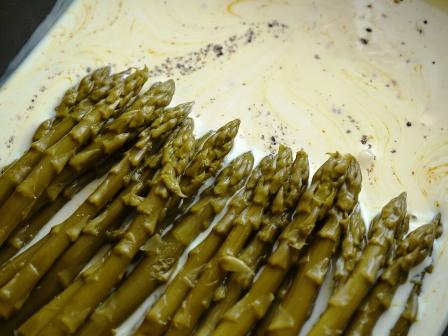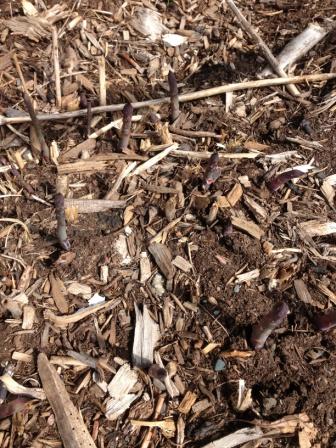Asparagu$ – The Dream Investment

For most folks investing these days is a sad joke - interest rates below 1% or a roller coaster stock market. If you're discouraged, take heart. An investment in asparagus futures will provide a substantial return on your investment and deliver a delicious and nutritious vegetable just at the time of the year when your body cries out for some truly fresh vegetables.
If you've eaten only asparagus from a supermarket or even a farmers market, then you really haven't tasted asparagus. Of course store bought asparagus drenched with Hollandaise sauce is very tasty, but then again so is crabgrass slathered with Hollandaise sauce. And the crabgrass is free. Asparagus from the market runs $4 a pound, and once you've cut off the inedible portion of the stalk, you're really looking at $6 a pound for a very poor substitute for the real stuff.
If I've managed to convince you that asparagus should be part of your garden, read on.
Asparagus is a perennial. It'll be two years from the time of initial planting of roots (3 years if you're foolish enough to start with seed) before you can reap a modest harvest, and a couple of more years until the plants are really in their prime. The good news is that a well tended bed of asparagus will last 15 or more years. For an expenditure of $25 you'll harvest hundreds of dollars worth of tasty and nutritious asparagus spears, delighting your family and inspiring awe and admiration in your neighbors. Let's see - $25 invested at 1% for ten years brings in $2.71 in interest -enough to buy half a pound of tasteless spears at the store. Even Warren Buffet would agree that an asparagus bed wins hands down over your local bank.
Getting Started
Asparagus needs full sun and its ferns grow 4 to 5 feet tall by summer’s end, so select a sunny spot in your garden where the asparagus won't shade sun-loving plants. Most folks select a spot on the north side of their garden.
Preparing the asparagus bed need not be a tremendous chore. I recommend a raised bed, but then again I'm a fervent believer in raised beds for all vegetables. Especially consider a raised bed if your soil is very clay-like. Add compost and dig into the existing soil. This work is best done in the fall, prior to the spring planting of the asparagus. Asparagus grows best in a soil with a pH of 7, so again, take time the previous fall to get the growing conditions optimized.
Asparagus plants need plenty of room. Keep them 18” apart for best long term results. Resist the temptation to crowd them because you don't want crowns you ordered to "go to waste". Give the extras to a neighbor, or even better, plant a second asparagus bed.
I recommend the “Jersey XXX” varieties of asparagus. They’re very heavy producers with good disease resistance. For $20-25 you get 25 roots, more than enough for the average bear.
For each plant dig a hole about 12" by 12" and 6" deep. In the center of the hole pour some soil to create a mini volcano about 4” high. Place the asparagus crown on top of the volcano with the roots running evenly down all sides. Then cover with soil so that just the tip of the crown is exposed. Keep watered and slowly fill in the hole as the asparagus begins to grow.
Harvest
The next spring resist the temptation to take more than 2-3 stalks per plant. The following year you can harvest a substantial number of spears from each plant. Take only the ones that are 1/4" or more in diameter.
There are two primary ways to harvest the spears. The first involves cutting the spears off at or below the ground line. An alternate is to bend over the spear until it breaks. It will do so at the dividing line between the tender edible portion of the spear and the inedible part. In both cases the spear should be 6” to 8” tall when harvested. Harvest normally starts in early April in the Northeast and goes well into May. When the spears start to come up with a 'open' tip you'll know it's time to cease harvesting.
The normal asparagus harvest runs for about 8 weeks. If you want to extend it, try one of these two techniques:
1. Pull back the heavy layer of mulch in early spring on only half your asparagus. When the spears begin to appear, pull back the mulch in the second half. Production in the second half will be delayed until the soil warms up.
2. Harvest half the asparagus in spring. Let the other half grow unimpeded. Then in late July, cut the plants in the second half down to the ground and wait for the plants to grow new spears which you can then harvest. If you employ this technique, then do it consistently. If you switch the harvest cycle for a group of plants you’re very likely to weaken them.
Maintenance
Keep your asparagus bed well weeded, well mulched and give it an occasional deep watering. Remember that the plants need to store up lots of energy for next spring's big push. In the late fall when the foliage has turned nearly all brown, trim the plants to about 2 inches above ground level. An electric hedge trimmer will make this chore go quickly. Mulch the beds lightly at first, but once the hard frosts appear, add a 4 to 6 inch layer of straw or your favorite mulch.

Asparagus has only one pest that is likely to torment you. The asparagus beetle (common and stripped) can prove quite persistent. Hand picking of both the beetles and their larvae can be an effective strategy. The beetle will scurry to the other side of the stalk when you approach, and will sometimes drop to the ground when you go to seize the little buggers. Be quick and merciless. Mid afternoon is the best time to play pick-a-beetle. Don’t overlook their gray larvae since they do the real chomping. It's also possible to spray for the beetles, but I won't go there. My experience is that even if you leave the beetles to their devices, the damage to plants is not all that devastating and by late June the infestation peters out.
Living the Dream
You may not be featured in the Wall Street Journal, but your asparagus bed should provide you with many happy returns for many a year. Warren Buffet is a big believer that investments should be made with the long term in mind. Maybe he just hasn’t yet discovered asparagus.
Author:Paul Zimmermann